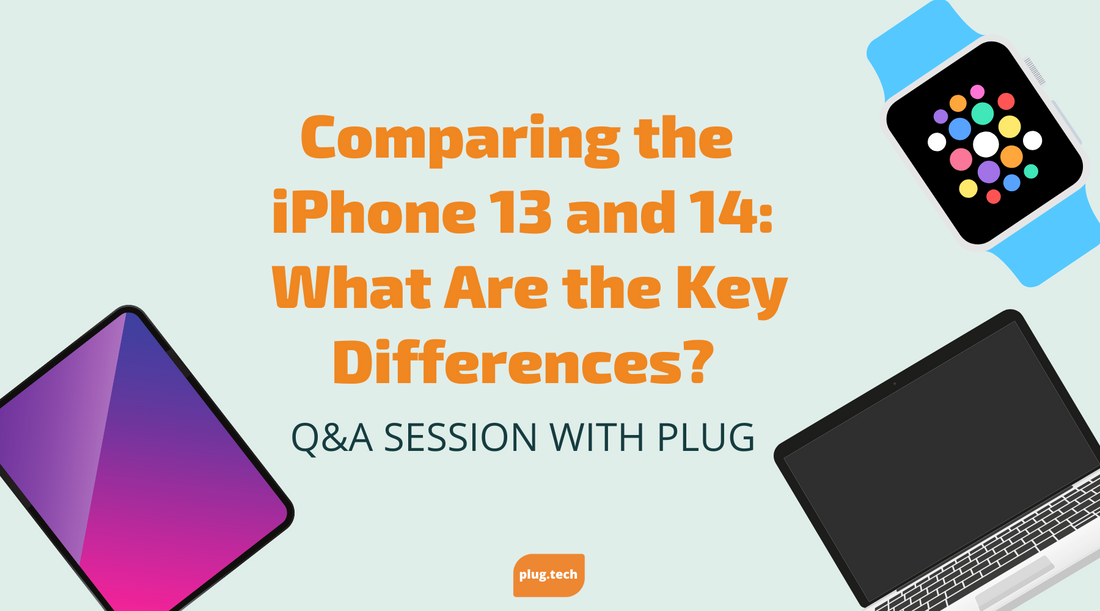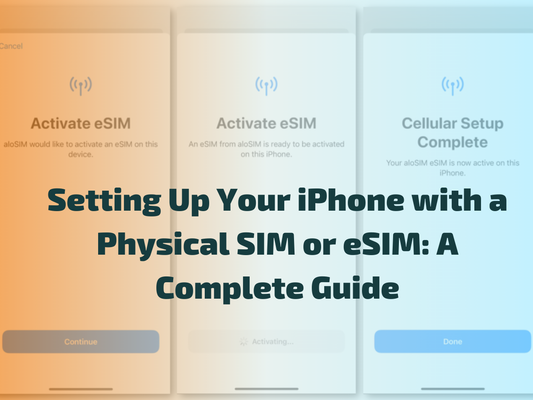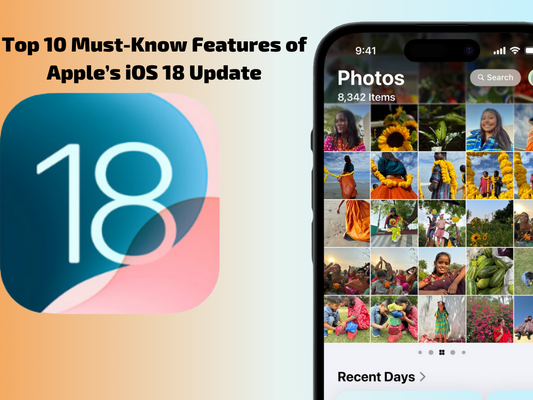
Comparing the iPhone 13 and 14: What Are the Key Differences?
Updated on | 11 mins readComparing the iPhone 13 and 14: What Are the Key Differences?
With the release of the iPhone 14, many users are wondering if it's worth upgrading from the iPhone 13. In this article, we'll take a closer look at the key differences between the two models in terms of design, display, performance, camera capabilities, and more. Let's dive in.
Design and Build
One of the most noticeable differences between the iPhone 13 and 14 is the exterior design. While the iPhone 13 features a flat-edge design, the iPhone 14 has a new look with curved edges that offer a more seamless feel. In terms of size and weight, the iPhone 14 is slightly smaller and lighter than the iPhone 13, but not by much.
Apple has always been known for its innovative design and the iPhone 14 is no exception. The curved edges of the iPhone 14 give it a more modern and sleek appearance compared to the flat edges of the iPhone 13. The smooth transition between the screen and edges also create a more seamless feel when swiping or tapping on the phone. The iPhone 14's design is more ergonomic, making it easier to hold and use for extended periods of time. The phone's curved edges also make it less likely to slip out of your hand, reducing the risk of accidental drops.
Additionally, the iPhone 14 features a redesigned camera system, with the lenses arranged diagonally instead of vertically as seen in the iPhone 13. This new camera system not only looks sleeker, but it also allows for improved camera performance. The diagonal arrangement of the lenses allows for better depth perception and improved low-light performance, making it easier to take stunning photos and videos even in less-than-ideal lighting conditions.
Size and Weight Comparison
While the iPhone 14 is slightly smaller and lighter than the iPhone 13, it's not a significant difference. The iPhone 13 measures 146.7 x 71.5 x 7.7 mm and weighs 204g, while the iPhone 14 comes in at 146.7 x 71.5 x 7.65 mm and weighs 195g. The difference in weight might be noticeable for some users, but the size difference is hardly noticeable at all. However, the slight reduction in size and weight makes the iPhone 14 even more portable and easier to carry around in your pocket or purse.
Color Options
Both models come in similar color options, with the iPhone 13 available in six colors (red, blue, midnight, starlight, pink, and product red) while the iPhone 14 comes in five colors (black, white, blue, product red, and green). The iPhone 14 also has a glossy finish, while the iPhone 13 has a matte finish. The glossy finish of the iPhone 14 gives it a more premium look and feel, while the matte finish of the iPhone 13 provides a more understated and subtle appearance.
Overall, the design and build of the iPhone 14 is a significant improvement over the iPhone 13. The curved edges and diagonal camera system make it a more modern and sleek device, while the reduction in size and weight make it even more portable and easier to use. The color options and finishes also provide users with more choices to suit their personal style and preferences. Apple's commitment to innovative design is clearly evident in the iPhone 14, making it a highly desirable device for smartphone users everywhere.
Display and Resolution
The display is one of the most important features of any smartphone, and the iPhone 13 and 14 are no exception. While both models offer excellent quality, there are some notable differences between the two.
When it comes to screen size, the iPhone 13 and 14 are quite similar, with both models featuring a 6.1-inch display. However, the iPhone 14 has a better screen-to-body ratio, which means that the display takes up more of the phone's front surface area. This gives the iPhone 14 a sleeker and more modern look compared to the iPhone 13.
Screen Size and Technology
One of the biggest differences between the iPhone 13 and 14 is their display technology. The iPhone 13 features a Super Retina XDR OLED display with a resolution of 2532 x 1170 pixels, while the iPhone 14's screen has a slightly better resolution of 2778 x 1284 pixels. This means that the iPhone 14's display is sharper and more detailed than the iPhone 13's.
But it's not just the resolution that sets the two models apart. The iPhone 14 also features a more advanced type of OLED display, known as LTPO OLED. This technology allows the display to use less power when showing static images, which can help to extend the phone's battery life. Additionally, LTPO OLED displays are known for offering deeper blacks and brighter colors compared to traditional OLED displays, which means that the iPhone 14's screen is even more vibrant and eye-catching than the iPhone 13's.
Resolution and Pixel Density
Another area where the iPhone 14 outshines the iPhone 13 is in its pixel density. The iPhone 14 boasts a pixel density of 460 pixels per inch (ppi), while the iPhone 13 has a pixel density of 460 ppi. This might not sound like a huge difference, but it means that the iPhone 14's display is even crisper and clearer than the iPhone 13's.
Brightness and Contrast
When it comes to brightness and contrast, the iPhone 14 and 13 are quite similar. Both models offer excellent brightness levels and vibrant colors, making them great for watching videos and playing games. However, the iPhone 14 has a slightly higher contrast ratio compared to the iPhone 13, which means that it can display deeper blacks and brighter whites. This makes the iPhone 14's screen better for viewing media in darker environments, such as when watching a movie in a dimly lit room.
In conclusion, while both the iPhone 13 and 14 have excellent displays, the iPhone 14's screen is slightly better in almost every way. With its higher resolution, more advanced OLED technology, and better pixel density, the iPhone 14 offers a truly stunning visual experience that is sure to impress even the most discerning smartphone users.
Performance and Hardware
When it comes to performance, the iPhone 14 has some significant upgrades compared to the iPhone 13. Let's take a closer look at the differences.
Processor and Speed
The iPhone 14 is powered by the new A15 Bionic chip, which offers faster processing speeds than the A14 chip found in the iPhone 13. This means that tasks such as browsing the web, playing games, and using multiple apps simultaneously will be smoother and faster on the iPhone 14.
The A15 Bionic chip is also more power-efficient than its predecessor, which means that the iPhone 14 will have better battery life than the iPhone 13.
Additionally, the A15 Bionic chip features a new Neural Engine that is capable of performing up to 15.8 trillion operations per second. This will allow for more advanced machine learning and artificial intelligence capabilities on the iPhone 14.
RAM and Storage Options
In terms of RAM and storage options, the iPhone 14 has more storage options than the iPhone 13, offering up to 1TB of internal storage. This is a significant increase from the maximum 512GB of internal storage available on the iPhone 13.
Both models have the same RAM, with the base model offering 6GB. While this may seem like a small amount compared to some Android devices, Apple's hardware and software optimization means that the iPhone 14 will still be able to handle demanding tasks with ease.
Battery Life and Charging
The battery life on the iPhone 14 is slightly better than the iPhone 13, with up to 22 hours of talk time compared to the iPhone 13's 20 hours. This is thanks in part to the more power-efficient A15 Bionic chip.
The iPhone 14 also supports faster charging, with the ability to charge up to 50% in 30 minutes using a 20W charger. This means that you can spend less time tethered to a charging cable and more time using your device.
Overall, the performance and hardware upgrades on the iPhone 14 make it a significant improvement over the iPhone 13. Whether you're a power user who demands the latest and greatest technology or just someone who wants a reliable and efficient smartphone, the iPhone 14 is sure to impress.
Camera Capabilities
The cameras on both the iPhone 13 and iPhone 14 are excellent, but the iPhone 14 offers a few improvements and new features that might make it more appealing for some users.
When it comes to smartphone photography, the camera is one of the most important features. With the iPhone 14, Apple has made significant improvements to the camera system, making it even better than the already impressive iPhone 13 camera.
Rear Camera Comparison
The iPhone 14 features a redesigned camera system with improved low-light capabilities and a larger sensor, which means it can capture more detail and produce less noise in low-light conditions. This is great news for anyone who loves taking photos in low-light situations, such as night-time cityscapes or indoor events.
In addition to the improved low-light capabilities, the iPhone 14 also has a new ProRes video mode that allows users to shoot in higher-quality video with more editing flexibility. This is a game-changer for anyone who wants to shoot professional-quality video on their smartphone.
Front Camera and Face ID
The front camera on the iPhone 14 has also been upgraded, with a new TrueDepth camera that offers improved face tracking and a higher-quality selfie camera. This means that your selfies will look even better than before, with more detail and better color accuracy.
Another important feature of the iPhone 14's front camera is the improved Face ID technology. Face ID is a secure and convenient way to unlock your phone, and with the iPhone 14, it's faster and more reliable than ever before.
Video Recording and Features
The iPhone 14 offers a range of new video features, including cinematic mode, which allows users to shoot video with a movie-like look, complete with depth-of-field effects. This is a great feature for anyone who wants to take their video content to the next level.
In addition to cinematic mode, the iPhone 14 also has improved stabilization for smoother video, and the ability to shoot ProRes video, which is a high-quality format typically used in professional productions. With these new features, the iPhone 14 is a great choice for anyone who wants to create high-quality video content on their smartphone.
Conclusion
Overall, the iPhone 14 offers some significant upgrades and new features over the iPhone 13, particularly in terms of design, display, and performance. However, whether or not it's worth upgrading ultimately depends on the individual users' needs and budget. If you're happy with your iPhone 13 and don't need the additional features, sticking with it might be the best option. But if you're in the market for a new phone and want the latest and greatest technology, the iPhone 14 is certainly worth considering.






